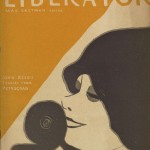Stephen Watt is a Professor of English and Associate Dean in the College of Arts and Sciences at Indiana University, Bloomington. He spent the month of June reading both manuscripts and published works in the Ransom Center’s Irish literature and Judaica collections. The result of this and further research, he hopes, will be a scholarly monograph that examines cultural interactions between Irish and Jewish immigrants in later nineteenth-century America, particularly theatrical ones, and the ways in which Irish-Jewish relations of the early twentieth century help define our sense of modern and modernist writing. His research was funded by a fellowship from the Dorot Foundation.
Occasionally at the end of the evening, I find myself “channel surfing” on the television seeking a momentary diversion or, even better, an effective sedative. Over the years, The Late Show with David Letterman has reliably provided both, and I have often enjoyed a skit on the show entitled “Is it Something or Is t Nothing?” Typically, the “it” in question is some kind of bizarre performance or an unlikely combination of objects, and it occurs to me that the scholarly book might be described in just these terms: a bizarre performance and/or an assemblage of facts or ideas that, at least at first glance, don’t necessarily appear related. Perhaps more relevant, the gestation of a scholarly book—the emotional highs produced by a surprising discovery and discouraging lows caused by doubt or lack of confidence—often reminds me of the Letterman show’s question: Is the project “something,” an intellectual intervention or creative achievement of some consequence, or is it “nothing?”
The fortunate recipient of a one-month fellowship at the Ransom Center generously provided by the Dorot Foundation, I came to Austin with an idea for a monograph, the working title of which is Irish Schlemiels: The Irish-Jewish Unconscious and American Modernism. I hoped it was “something” or would become such, but I wasn’t certain. The genealogy of the project includes the phrase “Irish schlemiels” in a wonderful poem by Northern Irish writer Paul Muldoon; a problematic analogy in Bernard MacLaverty’s 1997 novel Grace Notes between the horrors of World War II and those of the “Troubles” in Belfast and Derry; and my ongoing interest in the representation of Irishmen and Jews on the later nineteenth-century popular stage, both in New York and in the Dublin of James Joyce and Sean O’Casey’s adolescence in the 1890s. How, for example, did post-Famine Irish immigrants in the 1850s and 1860s affect representations of the Irish in America? How did the later diaspora of largely Eastern European Jews arriving in America in the 1880s and 90s inflect the cultural work done by theater at the fin de siècle? How does the popularity in both America and Ireland of such plays as Paul Potter’s Trilby and widely-seen revivals of The Merchant of Venice relate to the emergent populations of immigrants in America? Most important, how does this cultural interface affect American drama and fiction of the modernist period?
To be a little more candid, I actually arrived in Austin with rough drafts of the chapters dealing with later nineteenth-century immigrant drama and theater. But I was uncertain if I could outline and structure effectively the chapters on modernist writing. The Ransom Center’s collections of the manuscripts of such figures as Elmer Rice, Edward Dahlberg, and, in a more theatrical vein, Stella Adler helped enormously in clarifying this matter. In fact, the center’s holdings of Jewish American and Irish writing are enormous; a scholar could spend a blissful summer reading materials on any one of these artists—or on George Bernard Shaw, Kay Boyle, or Samuel Beckett, all of whose works I read while in residence. Dahlberg and Rice in particular, both under-studied and underappreciated, grew to assume great importance in my plans, which now include a chapter on Joyce, Dahlberg, and Henry Roth; and another on Synge and Shaw, Rice and Adler.
But this scarcely describes the unique items—now exceptionally important to Irish Schlemiels—that I uncovered in the Ransom Center. These include Rice’s Shavian one-act play A Diadem of Snow, sandwiched in a 1918 issue of The Liberator between radical editorials concerning lynchings in the American South and Jack Reed’s reports from the revolution in Russia; Leslie Daiker’s remarkable “The Circular Road,” a radio play concerning a young Jewish Dubliner grieving over the shooting of his father during the civil war of the 20s; Stella Adler’s incisive and exhaustive workbook for actors of one of Synge’s masterpieces, Riders to the Sea; and an exchange of letters between Dahlberg and Kay Boyle that adds great clarity to the former’s complicated view of James Joyce in general and Ulysses in particular. All of these materials will contribute significantly to my book, as will countless passages I found in these and other writers’ works
Of course, no scholarship ever evolves in a vacuum. When I wrote my fellowship application, several essays in what might be called the “New Jewish-Irish Studies” had appeared, and today the list of works in this area has been graced by two recent and very considerable achievements: Mick Moloney’s album of Tin Pan Alley songs, If It Wasn’t for the Irish and the Jews, and George Bornstein’s study The Colors of Zion (Harvard, 2011). My Irish Schlemiels doesn’t look—or shouldn’t be mistaken for—either of these. But it is my hope that it will be “something,” not “nothing,” and that this emergent field will both grow in importance and promote greater understanding of the cultures of two immigrant groups that contributed so substantially to this country. In either case or in both, the Ransom Center collections and truly outstanding staff will have played and will continue to play a major, much appreciated role.
Please click on the thumbnails below to view full-size images.



